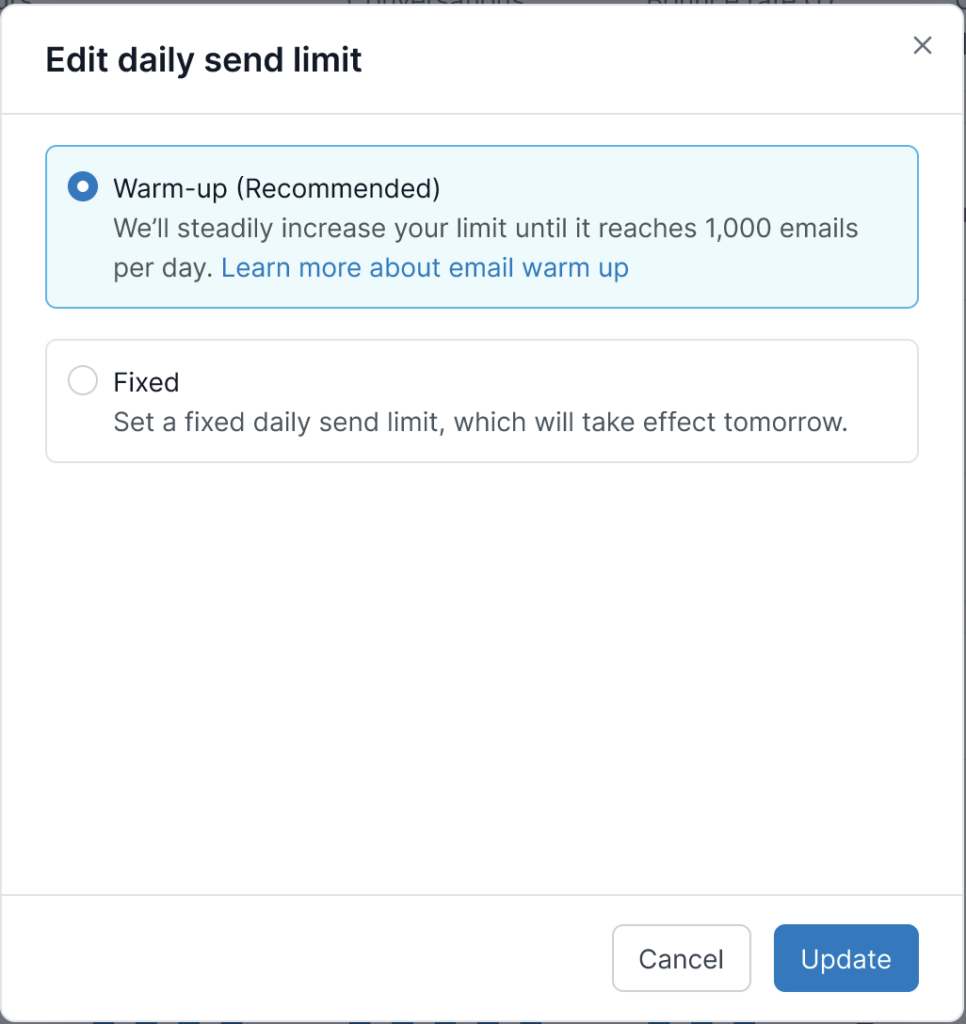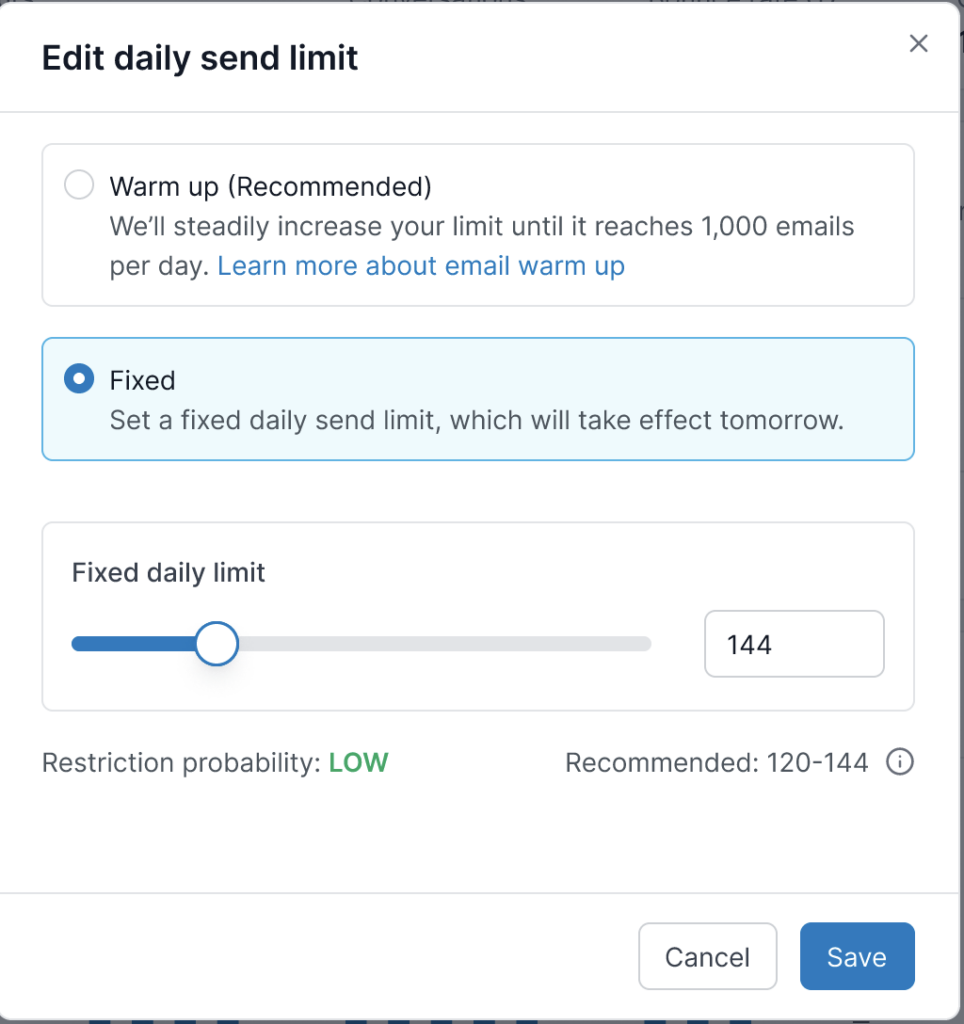Email warmup is the gradual process of building a positive sender reputation for a new AI Email (AIE) email agent account by slowly increasing the number of emails sent. By starting a campaign with smaller volumes, the warm-up process helps prevent your emails from being marked as spam by Email Service Providers (ESPs) and Internet Service Providers (ISPs).
Over time, as the sending volume steadily increases, and the campaign maintains good engagement (such as opens and replies), ESPs recognize the email account as a trustworthy sender. Therefore your campaign emails are more likely to land in recipients’ inboxes rather than the spam folders when you ramp up your campaigns.
Inbox warmup automatically adjusts the daily email limit to help you send more emails over time, without risking restrictions. AIE uses your sending history and inbox health to calculate the safest pace for increasing the email limit on a daily basis.
Benefits of email inbox warming include:
Automate growing your email volume at a pace less likely to result in ESPs sending the email to spam.
Automatic adjustments based on bounce rates prioritize long-term deliverability.
You can choose between automated warmup or use manual mode.
Prerequisites
An email provider’s email account connected to an AI email agent. Refer to Set Up Your AI Email Agent in AIE.
Set up AI email agent warming
You can setup either automatic mode or manual mode.
To set up email warming:
Go to the Daily send limit panel.
At the right side select Edit limit. The Edit daily send limit popup opens.
Select either Warm up or Fixed and follow the relevant steps in the next sections.

Set up a warm up limit
Select Warm up.
Select Update.
AIE steadily increases the limit until it reaches 1000 emails per day. See the How automatic inbox warming works section below for details.
Set up a fixed send limit
When you select Fixed, the Edit daily send limit popup opens.

Select a Fixed daily limit. AIE shows you the probability that emails will be restricted. Select a limit that shows a Low probability.
AIE provides a recommendation that is 100-120% of the current 10 working day average of emails sent. Note: Daily send limits are implemented at the Email Agent level, not at the campaign level.Select Save.
Daily send limit and warm-up status
If you already set up the send limit, the Daily send limit panel shows the type of limit, its status, the current number of the limit, and how many emails have been sent today out of the planned number to send. There’s a link to show the history.

Select the down icon at the bottom left to see more details about warm-up status. Also refer to the Daily adjustments status section below.

How automatic email agent warming works
After you set up email agent warming, it operates in phases, as follows.
10-day startup phase: AIE sends 20 emails/day.
Daily adjustments phase: Over the previous 10 days, AIE reviews these metrics every day:
Average emails sent per day, excluding weekends
Bounce rate (percentage of undelivered emails)
After reviewing the metrics, AIE adjusts the email daily send limit according to the daily adjustments status.
Daily adjustments status
The adjustment statuses are updated daily with the following warm up states:
Healthy
Bounce rate: <3%, which is considered to be a good rate.
Response: AIE increases sends by 20% on the 10 working day average.
Example:
Last 10 days email send volume = 35,36,37,38,39,41,42,43,45,46
Average emails sent: 40.2/day
Average bounce rate: 2%
New limit = 40 + (20% of 40) = 48
Caution
Bounce rate: 3-5%, which is considered to be less than good, but not bad.
Response: AIE continues to send at a daily rate limit that is the same as the last 10 working day’s average send rate
Example:
Last 10 days email send volume = 35,36,37,38,39,41,42,43,45,46
Average emails sent: 40.2/day
Bounce rate: 4%
New limit = average of last 10 days email sent = 40
Because AIE uses a rolling 10-day average, the new limit might occasionally be slightly lower than the previous day’s limit. This does not mean you are losing progress; it simply reflects the system’s attempt to keep send limits within a safe range while your bounce rate remains moderate.
Critical
Bounce rate: ≥ 5%, which means the inbox needs a correction to reduce the risk of it being flagged as spam.
Response: AIE lowers the daily limit by 20% of the 10-day average.
Example:
Last 10 days email send volume = 35,36,37,38,39,41,42,43,45,46
Average emails sent: 40.2/day
Bounce rate: 6%
New limit = 40 – (20% of 40) = 32
Best practices and tips
While Google and Outlook technically allow higher sending volumes, we recommend keeping your daily limit under 250 when using the Fixed limit.
If you choose to exceed this recommendation, AIE caps the manual limit at 1,600 emails/day for Gmail and 3200 emails/day for Outlook, to protect your domain’s reputation.
We recommend having an always-on campaign to keep the inbox warmed up, in case there are days when the inbox is inactive.
To scale the number of email sends faster, keep your bounce rates below 3%. The best way to do this is to use accurate email lists.
Google Apps’ email limit is 2000 per account per day. If your Gmail account is new or flagged, you are limited to 500 emails per account per day. Refer to Gmail sending limits in Google Workspace.
Outlook 365 limits depend on your account type.
Personal or Home outlook.com: 300 emails per day, 30 per minute, and up to 100 recipients per email. Refer to Limits for Outlook.com mailboxes and messages.
Business or Enterprise: 10,000 emails per day, 30 per minute, and 500 recipients per email. See Exchange Online limits.
FAQ
Why did the send limit decrease?
AIE decreases the number of emails sent when the bounce rate is ≥ 5%. We suggest improving the quality of the email list.
What happens if the manual limit is above 120% of the 10-day average, or higher than 200/day?
AIE identifies the agent as High Risk and displays a warning, but allows the emails to send.
Does CE predict when the target limit will be reached?
Yes. AIE provides an estimate, such as “At At a 20% growth rate with <3% bounce, you’ll reach 1000 emails/day by [date].”
What happens if an email agent is inactive for 10 or more working days?
The email agent reverts to the initial limit of 20 emails/day, restarting the warmup process. We recommend having an always-on campaign to keep the agent warmed up.
What counts towards daily send limits?
Introduction emails and follow-up emails count toward daily send limits. Replies from leads or contacts do not count toward these limits.